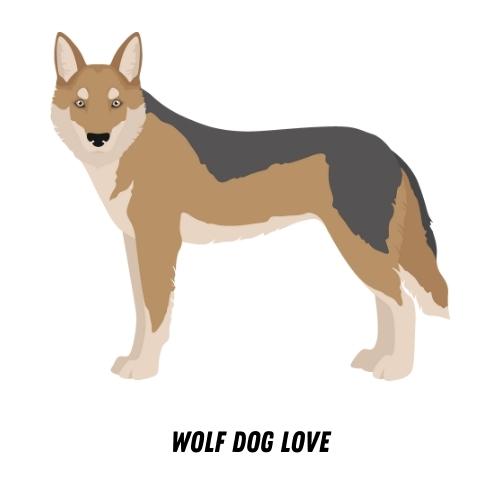Introduction to Wolf Dog Education
Wolf Dogs are fascinating creatures, a unique blend of domestic dog and wild wolf. They’re often misunderstood, which is why education about these animals is so crucial. In this section, we will discuss the importance of Wolf Dog education and address some common misconceptions about these intriguing animals.
- The importance of Wolf Dog Education
- Common misconceptions about Wolf Dogs
Wolf Dog education is vital for several reasons. Firstly, it helps us understand these animals better. Wolf Dogs are not just ordinary dogs; they have unique behaviors and needs that stem from their wild ancestry. By learning about them, we can provide them with the care and environment they need to thrive.
Secondly, education helps dispel myths and misconceptions about Wolf Dogs. Many people fear these animals due to misinformation. By educating ourselves and others, we can help change these perceptions and promote a more compassionate view of Wolf Dogs.
Lastly, education plays a crucial role in advocating for Wolf Dogs. Many Wolf Dogs end up in shelters or are euthanized because people don’t understand them. By spreading knowledge about these animals, we can help prevent these tragic outcomes.
There are many misconceptions about Wolf Dogs. One common myth is that they are dangerous or aggressive. While Wolf Dogs can be more challenging to handle than regular dogs due to their wild instincts, they are not inherently dangerous. With proper care, socialization, and training, they can be wonderful companions.
Another misconception is that Wolf Dogs are suitable pets for everyone. In reality, these animals require a lot of time, patience, and understanding. They are not recommended for first-time dog owners or those who cannot commit to their unique needs.
Lastly, some people believe that Wolf Dogs can live happily in a typical domestic setting. However, due to their wild heritage, they often require more space and mental stimulation than a regular dog. They are not apartment pets and need an environment that caters to their instinctual behaviors.
In the following sections, we will delve deeper into the behavior and characteristics of Wolf Dogs, the need for awareness and advocacy, and the various education initiatives for these animals. Stay tuned to learn more about the fascinating world of Wolf Dogs.
Understanding Wolf Dogs: Behavior and Characteristics
Wolf Dogs are unique creatures that exhibit a combination of traits from both wolves and dogs. Understanding their behavior and characteristics is crucial for their proper care and management. In this section, we will delve into the behavior of Wolf Dogs and how they differ from other breeds.
Wolf Dog Behavior Education
Wolf Dogs are not your typical pets. They possess a unique set of behaviors that set them apart from other breeds. Let’s explore these behaviors in detail.
- Understanding the behavior of Wolf Dogs
- How Wolf Dogs differ from other breeds
Wolf Dogs are highly intelligent and curious animals. They are known for their problem-solving skills and their ability to learn quickly. However, they also have a strong instinctual drive, which can make them challenging to handle at times. They are typically more active and require more mental and physical stimulation than most dog breeds.
Wolf Dogs are different from other breeds in many ways. They are generally larger and have a more robust build compared to most dog breeds. Behaviorally, they tend to be more independent and may not seek human companionship as much as other dogs. They also have a stronger prey drive and may not get along well with smaller pets.
Understanding the behavior of Wolf Dogs is a significant step towards ensuring their well-being. It is essential to remember that every Wolf Dog is an individual and may not exhibit all these behaviors. However, being aware of these general tendencies can help in managing and caring for these unique animals.
| Characteristics | Wolf Dogs | Other Breeds |
|---|---|---|
| Size | Larger | Varies |
| Independence | High | Varies |
| Prey Drive | High | Varies |
| Companionship Need | Low | High |
In conclusion, Wolf Dogs are unique animals with distinct behaviors and characteristics. Understanding these can help in providing them with the care and environment they need to thrive.
Characteristics of Wolf Dogs
Wolf Dogs are unique creatures, a blend of the wild and the domestic. They possess a set of characteristics that set them apart from other breeds. Let’s delve into their physical and behavioral traits.
-
Physical characteristics of Wolf Dogs
Wolf Dogs are known for their striking physical appearance. They are usually large, with males standing up to 33 inches tall at the shoulder and weighing between 70 and 120 pounds. Their coat colors range from white to black, with many shades of brown and gray in between. They have a thick double coat that keeps them warm in cold weather. Their eyes are typically amber or yellow, but some Wolf Dogs have blue or even multi-colored eyes.
Physical Feature Description Height Up to 33 inches at the shoulder Weight 70 to 120 pounds Coat Color White, black, brown, gray Eye Color Amber, yellow, blue, multi-colored -
Behavioral characteristics of Wolf Dogs
Wolf Dogs are known for their intelligence and independence. They are often described as being more challenging to train than other dog breeds due to their stubborn nature. However, with the right approach, they can be trained to follow commands. They are also known for their loyalty and protective instincts. Wolf Dogs are typically reserved around strangers but are very affectionate with their family members. They require a lot of mental and physical stimulation to prevent them from becoming bored and destructive.
Behavioral Trait Description Intelligence Highly intelligent, can be trained with the right approach Independence Stubborn and independent, requires consistent training Loyalty Loyal and protective of their family Social Behavior Reserved around strangers, affectionate with family
Advocating for Wolf Dogs: The Need for Awareness
Wolf Dogs are unique creatures that require our understanding and support. Advocacy for these animals is not just about protecting them, but also about raising awareness of their needs and characteristics. Let’s delve into the world of Wolf Dog advocacy and why it’s crucial.
Wolf Dog Advocacy
- Why advocating for Wolf Dogs is important
- Current advocacy efforts for Wolf Dogs
Wolf Dogs, a hybrid of wolves and domestic dogs, are often misunderstood due to their wild heritage. This misunderstanding can lead to neglect, abuse, and even euthanasia. Advocacy for Wolf Dogs is vital to educate the public about these animals, dispel myths, and promote responsible ownership. It’s about ensuring these animals are treated with the respect and care they deserve.
There are numerous organizations and individuals worldwide dedicated to advocating for Wolf Dogs. These advocates work tirelessly to rescue Wolf Dogs in need, provide them with proper care, and find them loving homes. They also focus on education, informing the public about the unique needs and characteristics of Wolf Dogs.
For instance, the National Wolf Dog Alliance (NWDA) is an organization that promotes responsible ownership and advocates for the welfare of Wolf Dogs. They provide resources for owners, conduct research, and work with lawmakers to ensure fair legislation for these animals.
Another example is the Wolf Dog Rescue Network, which rescues and rehomes Wolf Dogs in need. They also provide educational resources and support for Wolf Dog owners.
These advocacy efforts are making a significant difference, but there’s still a long way to go. By understanding and supporting these efforts, we can help ensure a brighter future for Wolf Dogs.
Wolf Dog Awareness Education
Wolf Dogs are a unique breed that requires understanding and care. Spreading awareness about them is crucial. Let’s explore how we can do this and look at some success stories of Wolf Dog awareness campaigns.
- How to Spread Awareness about Wolf Dogs
Spreading awareness about Wolf Dogs is a task that requires a strategic approach. Here are some steps that can be taken:
- Education: The first step is to educate people about Wolf Dogs. This includes their behavior, characteristics, and needs. This can be done through seminars, workshops, and online resources.
- Community Involvement: Engage local communities in awareness campaigns. Organize events where people can interact with Wolf Dogs and learn about them firsthand.
- Social Media: Use the power of social media to reach a larger audience. Share information, pictures, and stories about Wolf Dogs to raise awareness.
- Success Stories of Wolf Dog Awareness Campaigns
There have been several successful Wolf Dog awareness campaigns. Let’s look at a couple of examples:
| Campaign | Impact |
|---|---|
| Wolf Dog Rescue Foundation | The foundation has successfully rescued and rehomed hundreds of Wolf Dogs. Their awareness campaign has reached thousands of people, educating them about the needs and characteristics of Wolf Dogs. |
| Wolf Dog Awareness Week | This annual event has significantly increased awareness about Wolf Dogs. It has educated the public about the breed and has led to an increase in adoptions. |
In conclusion, spreading awareness about Wolf Dogs is crucial for their well-being. By educating the public and promoting understanding, we can ensure a better future for these unique animals.
Education Initiatives for Wolf Dogs
Education is a crucial aspect of ensuring the well-being of wolf dogs. This section will delve into the various training initiatives that have been developed to enhance the lives of these unique animals.
Wolf Dog Training Initiatives
Training wolf dogs requires a unique approach, given their distinctive characteristics and behaviors. Let’s explore some effective methods and successful case studies.
- Effective training methods for Wolf Dogs
- Positive Reinforcement: This method involves rewarding the wolf dog for good behavior, which encourages them to repeat it. Rewards can be treats, praise, or a favorite toy.
- Consistent Training: Consistency is key in training wolf dogs. They need to understand what is expected of them, and this is achieved through regular, consistent training.
- Socialization: Wolf dogs are naturally pack animals, so socialization with other dogs and humans is crucial for their development.
- Case studies of successful Wolf Dog training initiatives
- The Wolf Dog Project: This initiative successfully trained over 100 wolf dogs using positive reinforcement techniques. The project reported a significant improvement in the behavior of the wolf dogs, with fewer instances of aggression and anxiety.
- The Canine Rehabilitation Center: This center has a specialized program for wolf dogs. They use a combination of positive reinforcement, socialization, and consistent training to help wolf dogs adjust to living with humans.
Training a wolf dog is not the same as training a regular dog. It requires a more patient, understanding, and consistent approach. Here are some effective methods:
There are numerous examples of successful wolf dog training initiatives. Let’s look at a couple of them:
These initiatives show that with the right approach, wolf dogs can be trained effectively. The key is understanding their unique needs and behaviors, and using methods that work best for them.
Advocacy for Wolf Dog Breeds
Wolf Dogs are a unique breed that requires understanding, love, and advocacy. Advocacy for these breeds is crucial to ensure their well-being and survival. Here, we will discuss how to advocate for different Wolf Dog breeds and learn from successful advocacy campaigns.
- How to advocate for different Wolf Dog breeds
- Education: Learn about the different Wolf Dog breeds, their behaviors, needs, and characteristics. This knowledge will help you advocate effectively.
- Spread Awareness: Share your knowledge with others. Use social media, blogs, and community events to spread the word about Wolf Dogs.
- Support Shelters: Many Wolf Dogs end up in shelters due to misunderstanding and fear. Support these shelters by volunteering, donating, or adopting.
- Legislation: Advocate for laws that protect Wolf Dogs and ensure their fair treatment.
- Key takeaways from successful Wolf Dog breed advocacy campaigns
Advocating for Wolf Dog breeds involves educating oneself and others about these unique animals. It’s important to understand their behavior, needs, and characteristics. Here are some steps to follow:
Successful advocacy campaigns for Wolf Dog breeds have taught us valuable lessons. Here are some key takeaways:
| Campaign | Key Takeaway |
|---|---|
| Wolf Dog Rescue Foundation | Education and awareness can significantly reduce the number of Wolf Dogs in shelters. |
| International Wolf Center | Legislation plays a crucial role in protecting Wolf Dogs and ensuring their fair treatment. |
| Wolf Dog Advocacy Network | Community involvement and support are vital for successful advocacy. |
In conclusion, advocating for Wolf Dog breeds requires education, awareness, support, and legislative action. By learning from successful campaigns, we can all play a part in ensuring the well-being and survival of these unique animals.
Conclusion: The Future of Wolf Dog Understanding
As we wrap up our discussion on Wolf Dogs, it is important to look towards the future. The understanding and acceptance of these unique creatures is a journey that is far from over. Let’s delve into the role of education in this journey and the future prospects for Wolf Dog advocacy and education.
- The role of education in improving Wolf Dog understanding
- Future prospects for Wolf Dog advocacy and education
Education plays a pivotal role in enhancing our understanding of Wolf Dogs. By learning about their behavior, characteristics, and needs, we can dispel myths and misconceptions that often lead to fear and misunderstanding. For instance, many people believe that Wolf Dogs are aggressive and dangerous, but studies show that they are just as capable of being loving and loyal companions as any other dog breed.
Education initiatives can take many forms, from school programs to public awareness campaigns. These initiatives can help people understand that Wolf Dogs are not wild animals, but rather domestic pets that require special care and understanding. By educating the public, we can foster a more compassionate and informed attitude towards these animals.
The future of Wolf Dog advocacy and education looks promising. More and more organizations are recognizing the need for Wolf Dog education and are taking steps to provide it. These efforts are crucial in promoting the welfare of Wolf Dogs and ensuring that they are treated with the respect and care they deserve.
For instance, some organizations are developing educational materials and resources to help potential Wolf Dog owners understand the unique needs and challenges of these animals. Others are advocating for legislative changes to protect Wolf Dogs and ensure their rights. With continued efforts in education and advocacy, we can look forward to a future where Wolf Dogs are better understood and appreciated.
In conclusion, the journey towards understanding and accepting Wolf Dogs is a long one, but with education and advocacy, we can make significant strides. Let’s continue to learn, share, and advocate for these remarkable creatures, and look forward to a future where they are valued and respected as they should be.








